Comprehensive Financial Budgeting, Analysis, and Performance Report
VerifiedAdded on 2020/06/05
|22
|5815
|32
Report
AI Summary
This comprehensive report delves into the core principles of budgeting and financial management. It begins with an introduction to budgeting, emphasizing its importance in forecasting expenditures and revenues. The report then presents various assessments, including sales, purchase, and expense budgets, followed by an analysis of income statements and cash flow projections. It explores flexible budgets, performance reports, and variance analysis to evaluate financial performance. The report also discusses the advantages and disadvantages of budgeting, providing a balanced view of its utility. Furthermore, it includes detailed case studies, such as the 'Pete Sampras' example, demonstrating the practical application of budgeting tools. The conclusion synthesizes the key findings, reinforcing the significance of budgeting in effective financial management, supported by references to relevant literature.
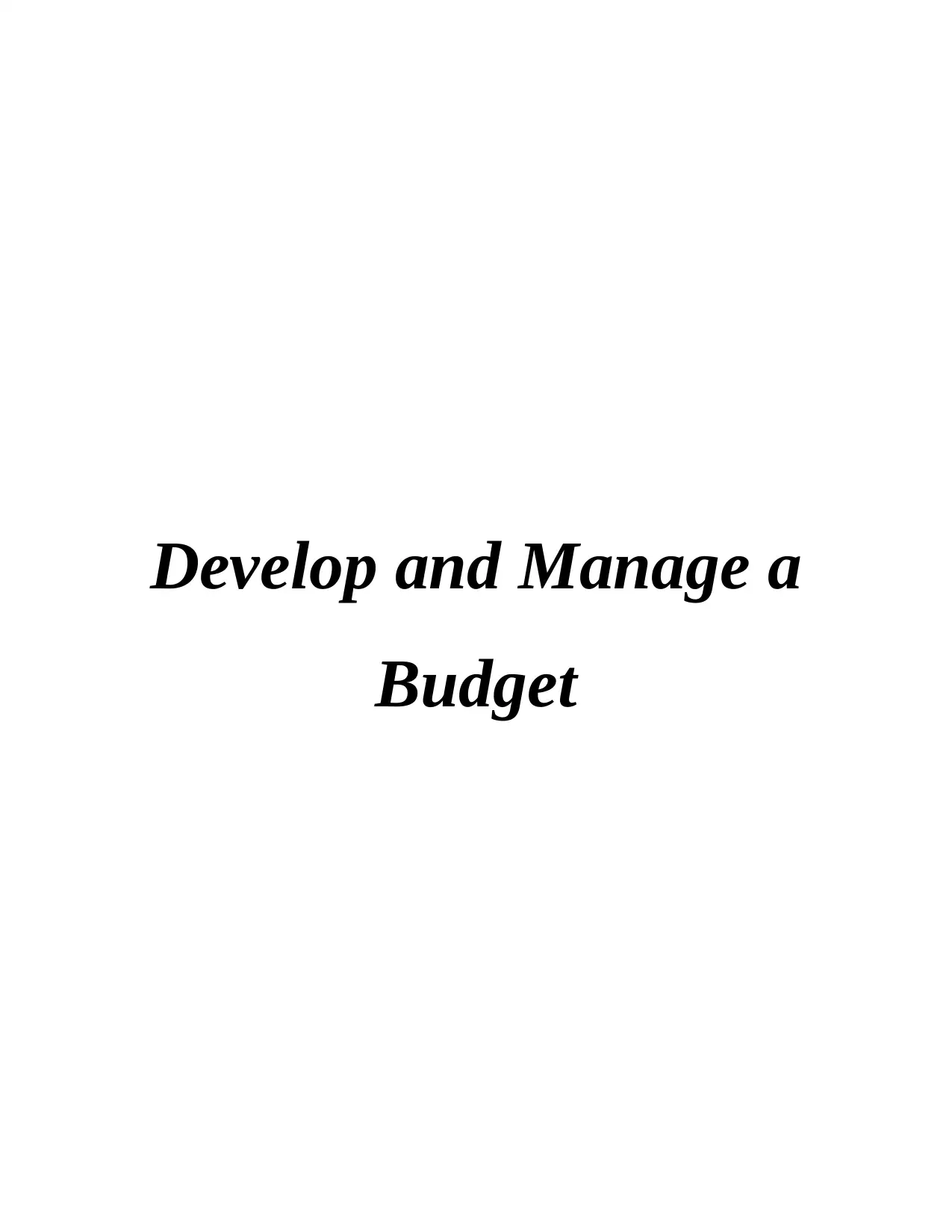
Develop and Manage a
Budget
Budget
Paraphrase This Document
Need a fresh take? Get an instant paraphrase of this document with our AI Paraphraser

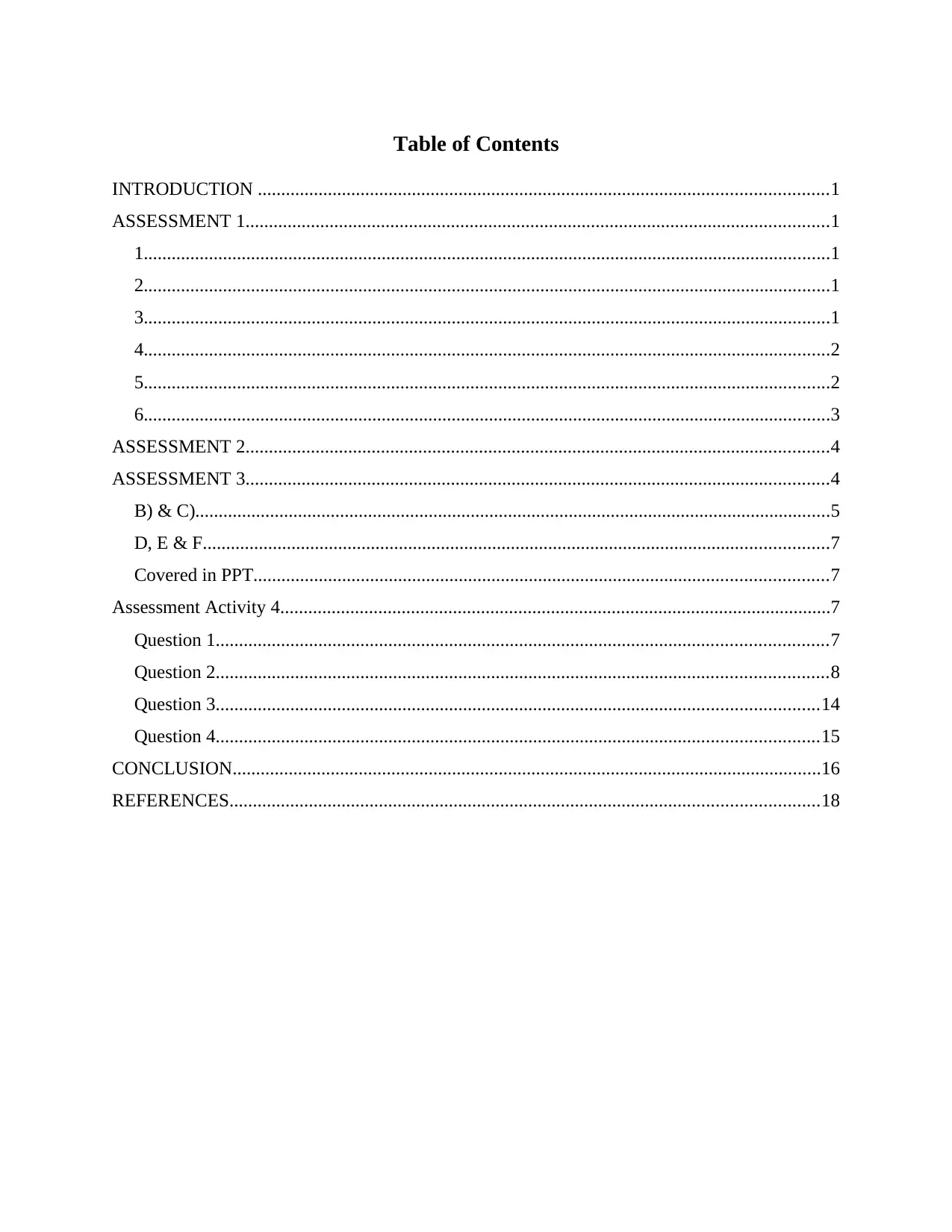
Table of Contents
INTRODUCTION ..........................................................................................................................1
ASSESSMENT 1.............................................................................................................................1
1...................................................................................................................................................1
2...................................................................................................................................................1
3...................................................................................................................................................1
4...................................................................................................................................................2
5...................................................................................................................................................2
6...................................................................................................................................................3
ASSESSMENT 2.............................................................................................................................4
ASSESSMENT 3.............................................................................................................................4
B) & C)........................................................................................................................................5
D, E & F......................................................................................................................................7
Covered in PPT...........................................................................................................................7
Assessment Activity 4......................................................................................................................7
Question 1...................................................................................................................................7
Question 2...................................................................................................................................8
Question 3.................................................................................................................................14
Question 4.................................................................................................................................15
CONCLUSION..............................................................................................................................16
REFERENCES..............................................................................................................................18
INTRODUCTION ..........................................................................................................................1
ASSESSMENT 1.............................................................................................................................1
1...................................................................................................................................................1
2...................................................................................................................................................1
3...................................................................................................................................................1
4...................................................................................................................................................2
5...................................................................................................................................................2
6...................................................................................................................................................3
ASSESSMENT 2.............................................................................................................................4
ASSESSMENT 3.............................................................................................................................4
B) & C)........................................................................................................................................5
D, E & F......................................................................................................................................7
Covered in PPT...........................................................................................................................7
Assessment Activity 4......................................................................................................................7
Question 1...................................................................................................................................7
Question 2...................................................................................................................................8
Question 3.................................................................................................................................14
Question 4.................................................................................................................................15
CONCLUSION..............................................................................................................................16
REFERENCES..............................................................................................................................18
⊘ This is a preview!⊘
Do you want full access?
Subscribe today to unlock all pages.

Trusted by 1+ million students worldwide
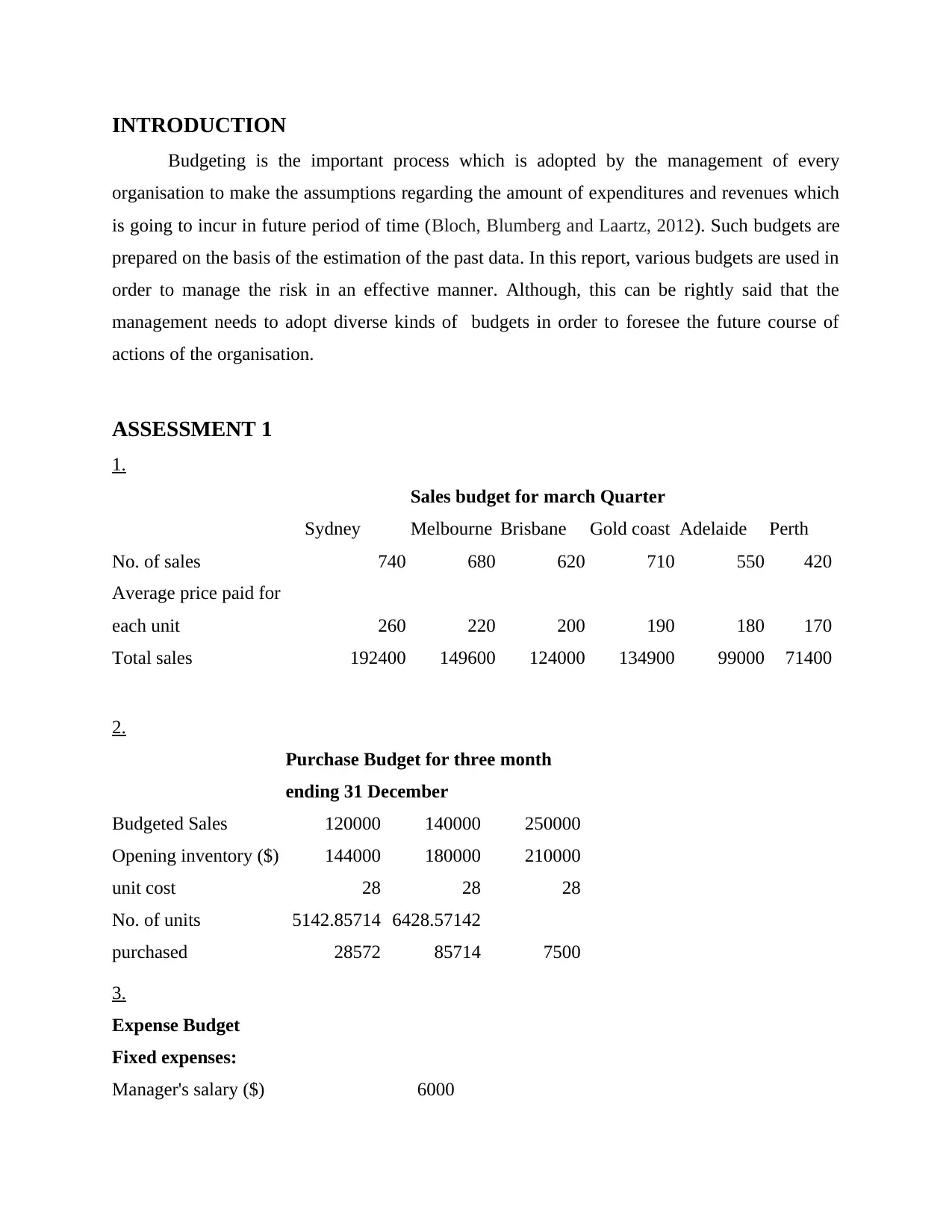
INTRODUCTION
Budgeting is the important process which is adopted by the management of every
organisation to make the assumptions regarding the amount of expenditures and revenues which
is going to incur in future period of time (Bloch, Blumberg and Laartz, 2012). Such budgets are
prepared on the basis of the estimation of the past data. In this report, various budgets are used in
order to manage the risk in an effective manner. Although, this can be rightly said that the
management needs to adopt diverse kinds of budgets in order to foresee the future course of
actions of the organisation.
ASSESSMENT 1
1.
Sales budget for march Quarter
Sydney Melbourne Brisbane Gold coast Adelaide Perth
No. of sales 740 680 620 710 550 420
Average price paid for
each unit 260 220 200 190 180 170
Total sales 192400 149600 124000 134900 99000 71400
2.
Purchase Budget for three month
ending 31 December
Budgeted Sales 120000 140000 250000
Opening inventory ($) 144000 180000 210000
unit cost 28 28 28
No. of units
purchased
5142.85714
28572
6428.57142
85714 7500
3.
Expense Budget
Fixed expenses:
Manager's salary ($) 6000
Budgeting is the important process which is adopted by the management of every
organisation to make the assumptions regarding the amount of expenditures and revenues which
is going to incur in future period of time (Bloch, Blumberg and Laartz, 2012). Such budgets are
prepared on the basis of the estimation of the past data. In this report, various budgets are used in
order to manage the risk in an effective manner. Although, this can be rightly said that the
management needs to adopt diverse kinds of budgets in order to foresee the future course of
actions of the organisation.
ASSESSMENT 1
1.
Sales budget for march Quarter
Sydney Melbourne Brisbane Gold coast Adelaide Perth
No. of sales 740 680 620 710 550 420
Average price paid for
each unit 260 220 200 190 180 170
Total sales 192400 149600 124000 134900 99000 71400
2.
Purchase Budget for three month
ending 31 December
Budgeted Sales 120000 140000 250000
Opening inventory ($) 144000 180000 210000
unit cost 28 28 28
No. of units
purchased
5142.85714
28572
6428.57142
85714 7500
3.
Expense Budget
Fixed expenses:
Manager's salary ($) 6000
Paraphrase This Document
Need a fresh take? Get an instant paraphrase of this document with our AI Paraphraser
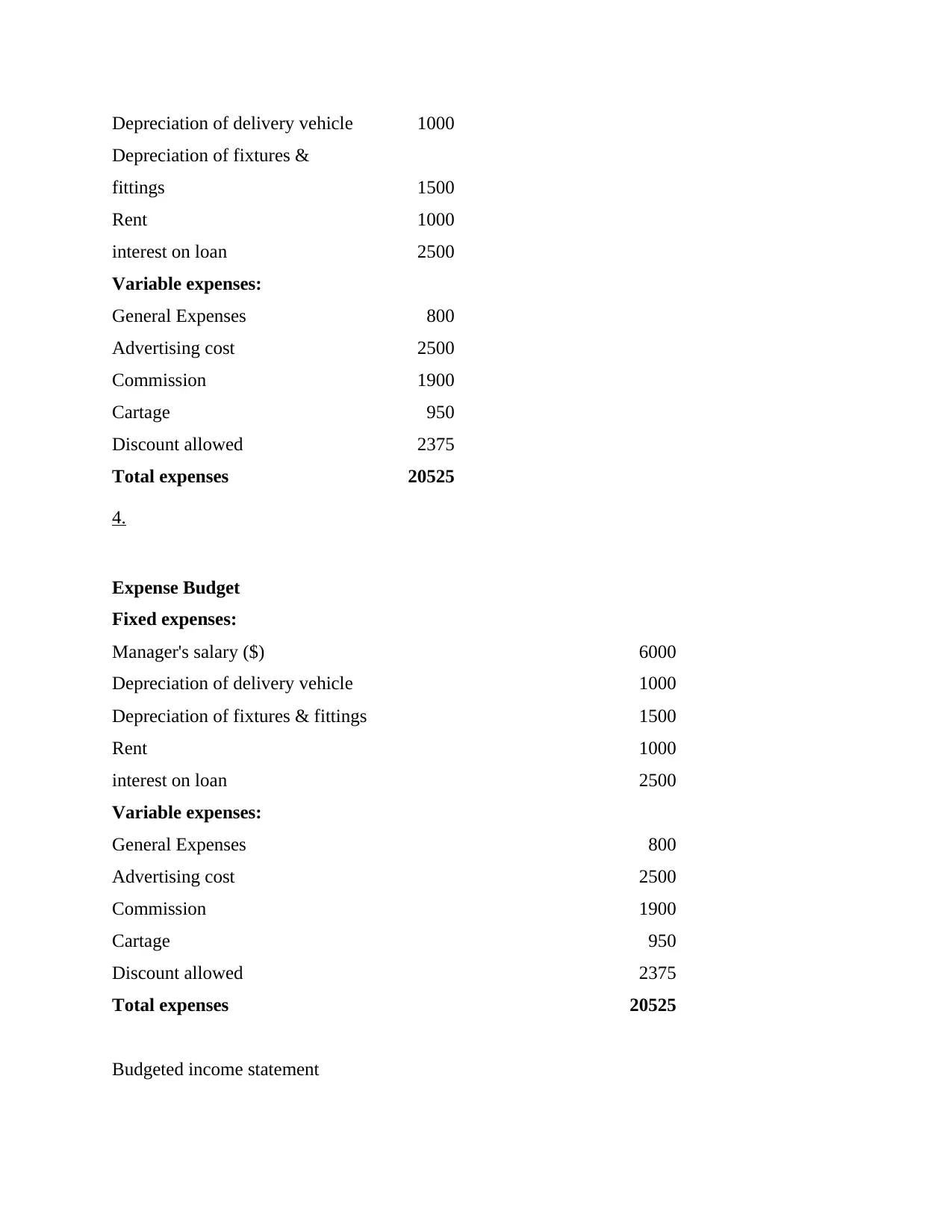
Depreciation of delivery vehicle 1000
Depreciation of fixtures &
fittings 1500
Rent 1000
interest on loan 2500
Variable expenses:
General Expenses 800
Advertising cost 2500
Commission 1900
Cartage 950
Discount allowed 2375
Total expenses 20525
4.
Expense Budget
Fixed expenses:
Manager's salary ($) 6000
Depreciation of delivery vehicle 1000
Depreciation of fixtures & fittings 1500
Rent 1000
interest on loan 2500
Variable expenses:
General Expenses 800
Advertising cost 2500
Commission 1900
Cartage 950
Discount allowed 2375
Total expenses 20525
Budgeted income statement
Depreciation of fixtures &
fittings 1500
Rent 1000
interest on loan 2500
Variable expenses:
General Expenses 800
Advertising cost 2500
Commission 1900
Cartage 950
Discount allowed 2375
Total expenses 20525
4.
Expense Budget
Fixed expenses:
Manager's salary ($) 6000
Depreciation of delivery vehicle 1000
Depreciation of fixtures & fittings 1500
Rent 1000
interest on loan 2500
Variable expenses:
General Expenses 800
Advertising cost 2500
Commission 1900
Cartage 950
Discount allowed 2375
Total expenses 20525
Budgeted income statement
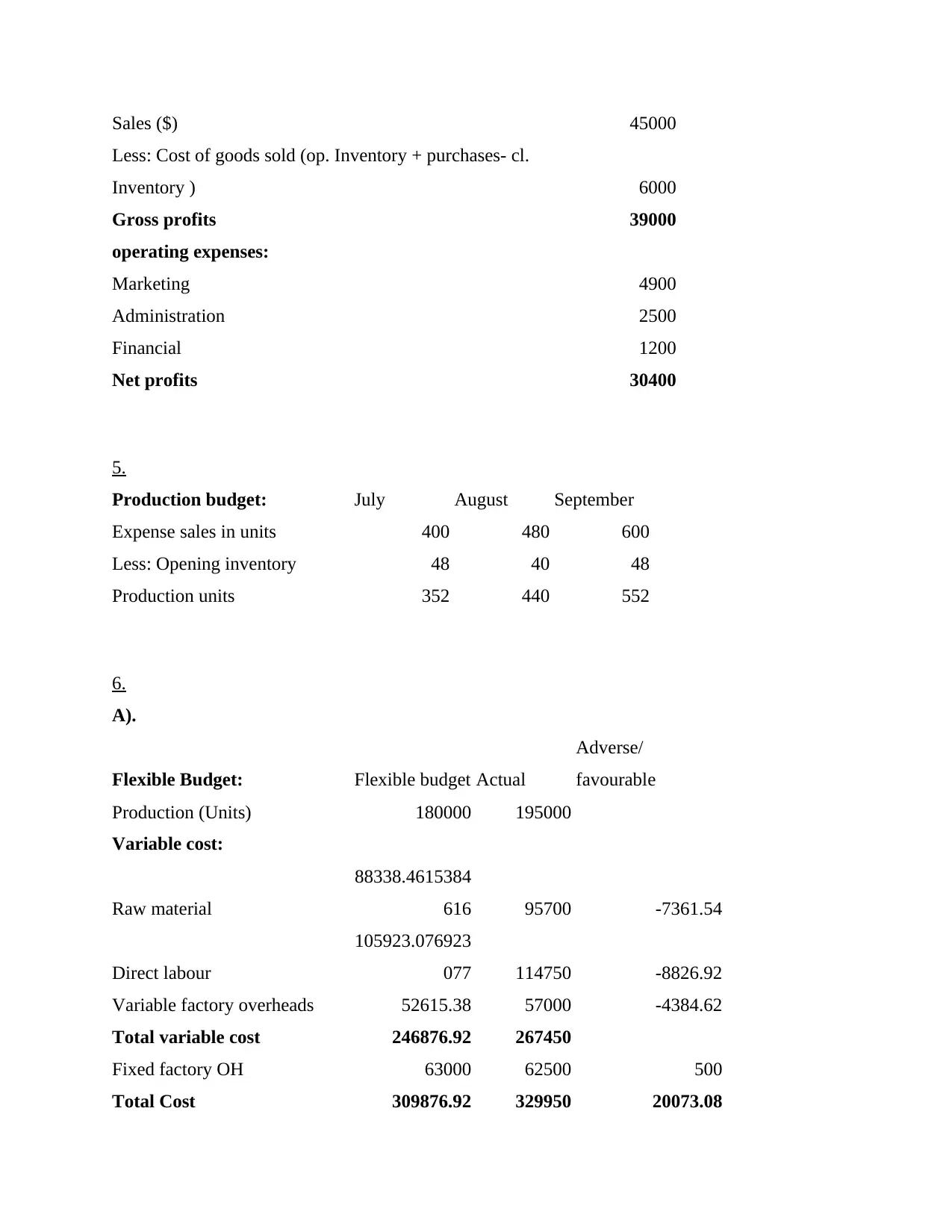
Sales ($) 45000
Less: Cost of goods sold (op. Inventory + purchases- cl.
Inventory ) 6000
Gross profits 39000
operating expenses:
Marketing 4900
Administration 2500
Financial 1200
Net profits 30400
5.
Production budget: July August September
Expense sales in units 400 480 600
Less: Opening inventory 48 40 48
Production units 352 440 552
6.
A).
Flexible Budget: Flexible budget Actual
Adverse/
favourable
Production (Units) 180000 195000
Variable cost:
Raw material
88338.4615384
616 95700 -7361.54
Direct labour
105923.076923
077 114750 -8826.92
Variable factory overheads 52615.38 57000 -4384.62
Total variable cost 246876.92 267450
Fixed factory OH 63000 62500 500
Total Cost 309876.92 329950 20073.08
Less: Cost of goods sold (op. Inventory + purchases- cl.
Inventory ) 6000
Gross profits 39000
operating expenses:
Marketing 4900
Administration 2500
Financial 1200
Net profits 30400
5.
Production budget: July August September
Expense sales in units 400 480 600
Less: Opening inventory 48 40 48
Production units 352 440 552
6.
A).
Flexible Budget: Flexible budget Actual
Adverse/
favourable
Production (Units) 180000 195000
Variable cost:
Raw material
88338.4615384
616 95700 -7361.54
Direct labour
105923.076923
077 114750 -8826.92
Variable factory overheads 52615.38 57000 -4384.62
Total variable cost 246876.92 267450
Fixed factory OH 63000 62500 500
Total Cost 309876.92 329950 20073.08
⊘ This is a preview!⊘
Do you want full access?
Subscribe today to unlock all pages.

Trusted by 1+ million students worldwide
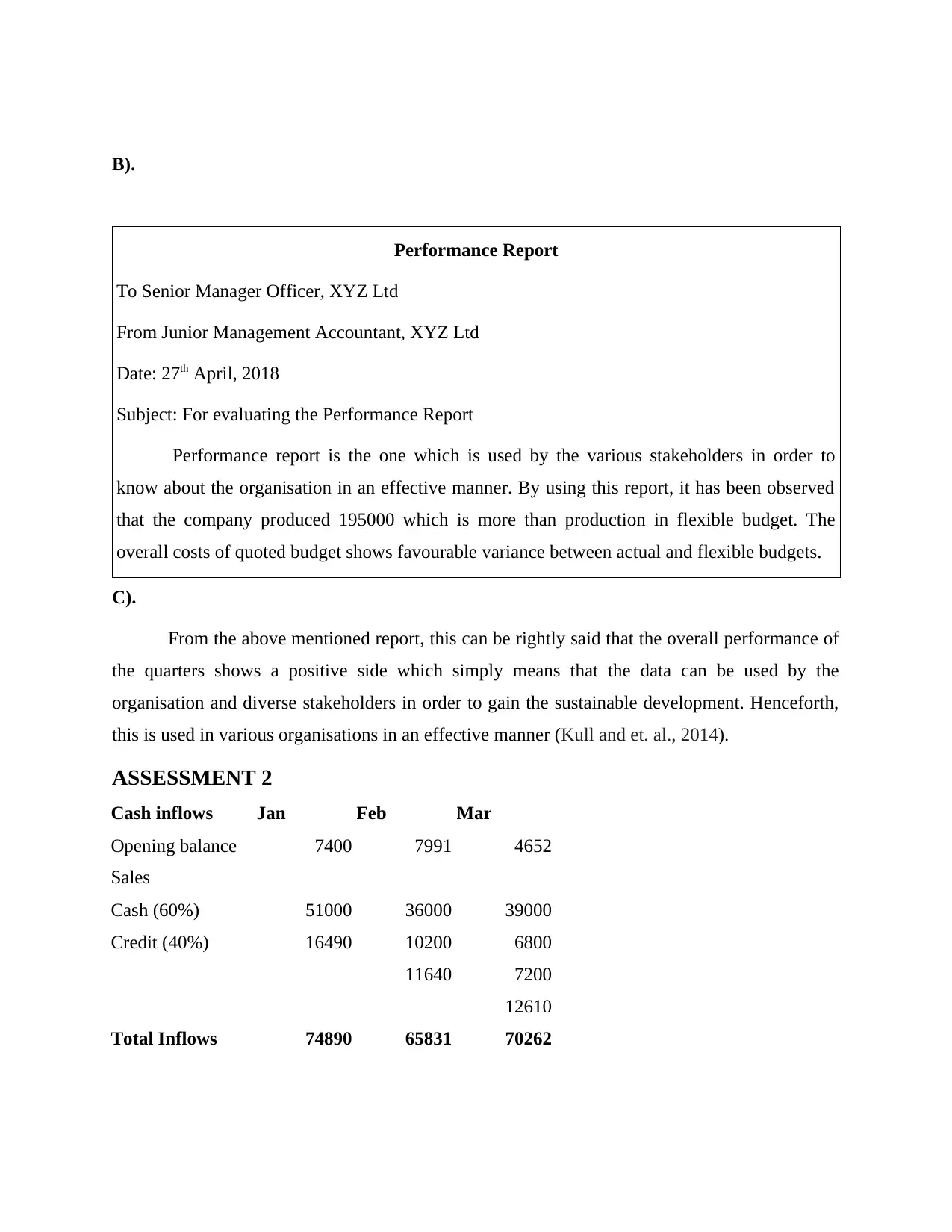
B).
Performance Report
To Senior Manager Officer, XYZ Ltd
From Junior Management Accountant, XYZ Ltd
Date: 27th April, 2018
Subject: For evaluating the Performance Report
Performance report is the one which is used by the various stakeholders in order to
know about the organisation in an effective manner. By using this report, it has been observed
that the company produced 195000 which is more than production in flexible budget. The
overall costs of quoted budget shows favourable variance between actual and flexible budgets.
C).
From the above mentioned report, this can be rightly said that the overall performance of
the quarters shows a positive side which simply means that the data can be used by the
organisation and diverse stakeholders in order to gain the sustainable development. Henceforth,
this is used in various organisations in an effective manner (Kull and et. al., 2014).
ASSESSMENT 2
Cash inflows Jan Feb Mar
Opening balance 7400 7991 4652
Sales
Cash (60%) 51000 36000 39000
Credit (40%) 16490 10200 6800
11640 7200
12610
Total Inflows 74890 65831 70262
Performance Report
To Senior Manager Officer, XYZ Ltd
From Junior Management Accountant, XYZ Ltd
Date: 27th April, 2018
Subject: For evaluating the Performance Report
Performance report is the one which is used by the various stakeholders in order to
know about the organisation in an effective manner. By using this report, it has been observed
that the company produced 195000 which is more than production in flexible budget. The
overall costs of quoted budget shows favourable variance between actual and flexible budgets.
C).
From the above mentioned report, this can be rightly said that the overall performance of
the quarters shows a positive side which simply means that the data can be used by the
organisation and diverse stakeholders in order to gain the sustainable development. Henceforth,
this is used in various organisations in an effective manner (Kull and et. al., 2014).
ASSESSMENT 2
Cash inflows Jan Feb Mar
Opening balance 7400 7991 4652
Sales
Cash (60%) 51000 36000 39000
Credit (40%) 16490 10200 6800
11640 7200
12610
Total Inflows 74890 65831 70262
Paraphrase This Document
Need a fresh take? Get an instant paraphrase of this document with our AI Paraphraser
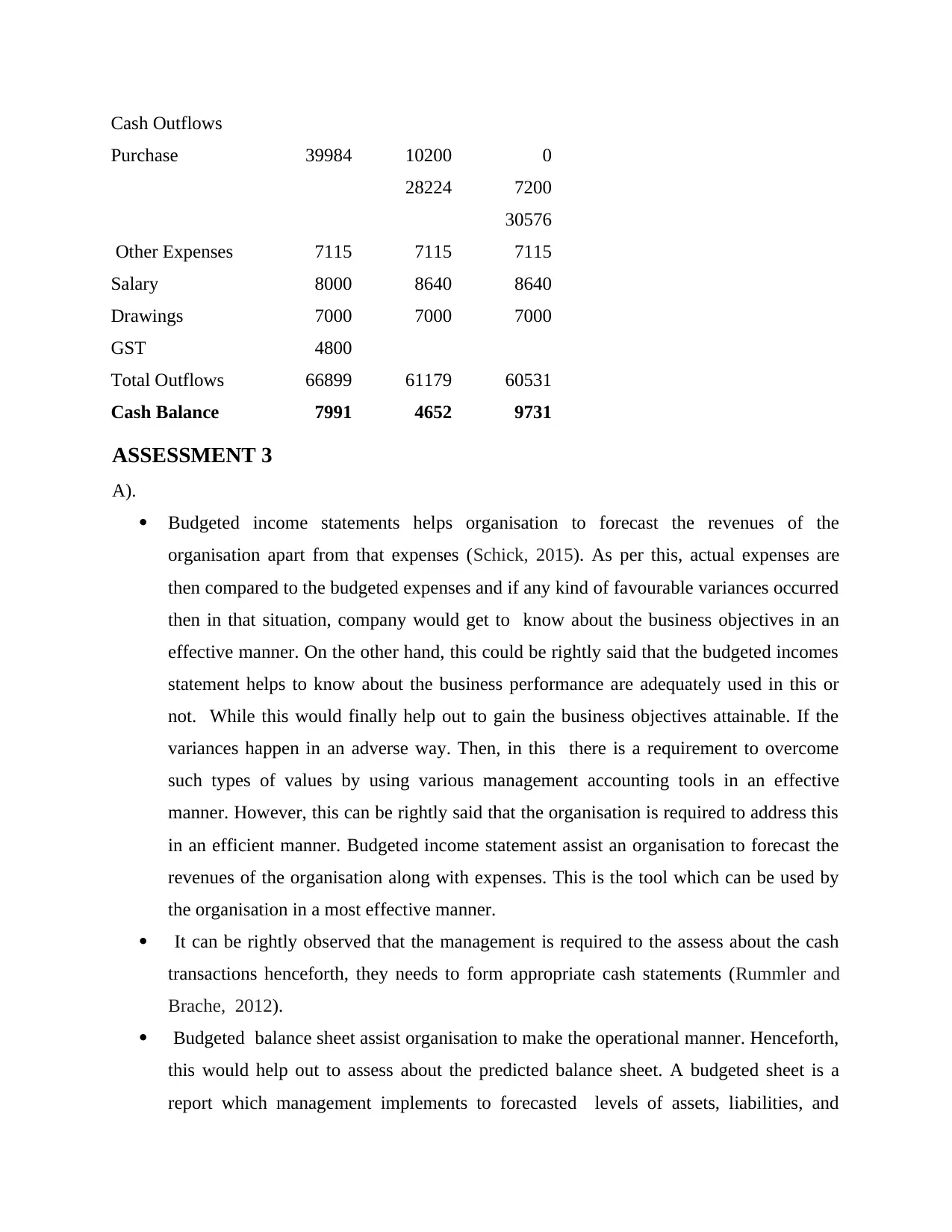
Cash Outflows
Purchase 39984 10200 0
28224 7200
30576
Other Expenses 7115 7115 7115
Salary 8000 8640 8640
Drawings 7000 7000 7000
GST 4800
Total Outflows 66899 61179 60531
Cash Balance 7991 4652 9731
ASSESSMENT 3
A).
Budgeted income statements helps organisation to forecast the revenues of the
organisation apart from that expenses (Schick, 2015). As per this, actual expenses are
then compared to the budgeted expenses and if any kind of favourable variances occurred
then in that situation, company would get to know about the business objectives in an
effective manner. On the other hand, this could be rightly said that the budgeted incomes
statement helps to know about the business performance are adequately used in this or
not. While this would finally help out to gain the business objectives attainable. If the
variances happen in an adverse way. Then, in this there is a requirement to overcome
such types of values by using various management accounting tools in an effective
manner. However, this can be rightly said that the organisation is required to address this
in an efficient manner. Budgeted income statement assist an organisation to forecast the
revenues of the organisation along with expenses. This is the tool which can be used by
the organisation in a most effective manner.
It can be rightly observed that the management is required to the assess about the cash
transactions henceforth, they needs to form appropriate cash statements (Rummler and
Brache, 2012).
Budgeted balance sheet assist organisation to make the operational manner. Henceforth,
this would help out to assess about the predicted balance sheet. A budgeted sheet is a
report which management implements to forecasted levels of assets, liabilities, and
Purchase 39984 10200 0
28224 7200
30576
Other Expenses 7115 7115 7115
Salary 8000 8640 8640
Drawings 7000 7000 7000
GST 4800
Total Outflows 66899 61179 60531
Cash Balance 7991 4652 9731
ASSESSMENT 3
A).
Budgeted income statements helps organisation to forecast the revenues of the
organisation apart from that expenses (Schick, 2015). As per this, actual expenses are
then compared to the budgeted expenses and if any kind of favourable variances occurred
then in that situation, company would get to know about the business objectives in an
effective manner. On the other hand, this could be rightly said that the budgeted incomes
statement helps to know about the business performance are adequately used in this or
not. While this would finally help out to gain the business objectives attainable. If the
variances happen in an adverse way. Then, in this there is a requirement to overcome
such types of values by using various management accounting tools in an effective
manner. However, this can be rightly said that the organisation is required to address this
in an efficient manner. Budgeted income statement assist an organisation to forecast the
revenues of the organisation along with expenses. This is the tool which can be used by
the organisation in a most effective manner.
It can be rightly observed that the management is required to the assess about the cash
transactions henceforth, they needs to form appropriate cash statements (Rummler and
Brache, 2012).
Budgeted balance sheet assist organisation to make the operational manner. Henceforth,
this would help out to assess about the predicted balance sheet. A budgeted sheet is a
report which management implements to forecasted levels of assets, liabilities, and
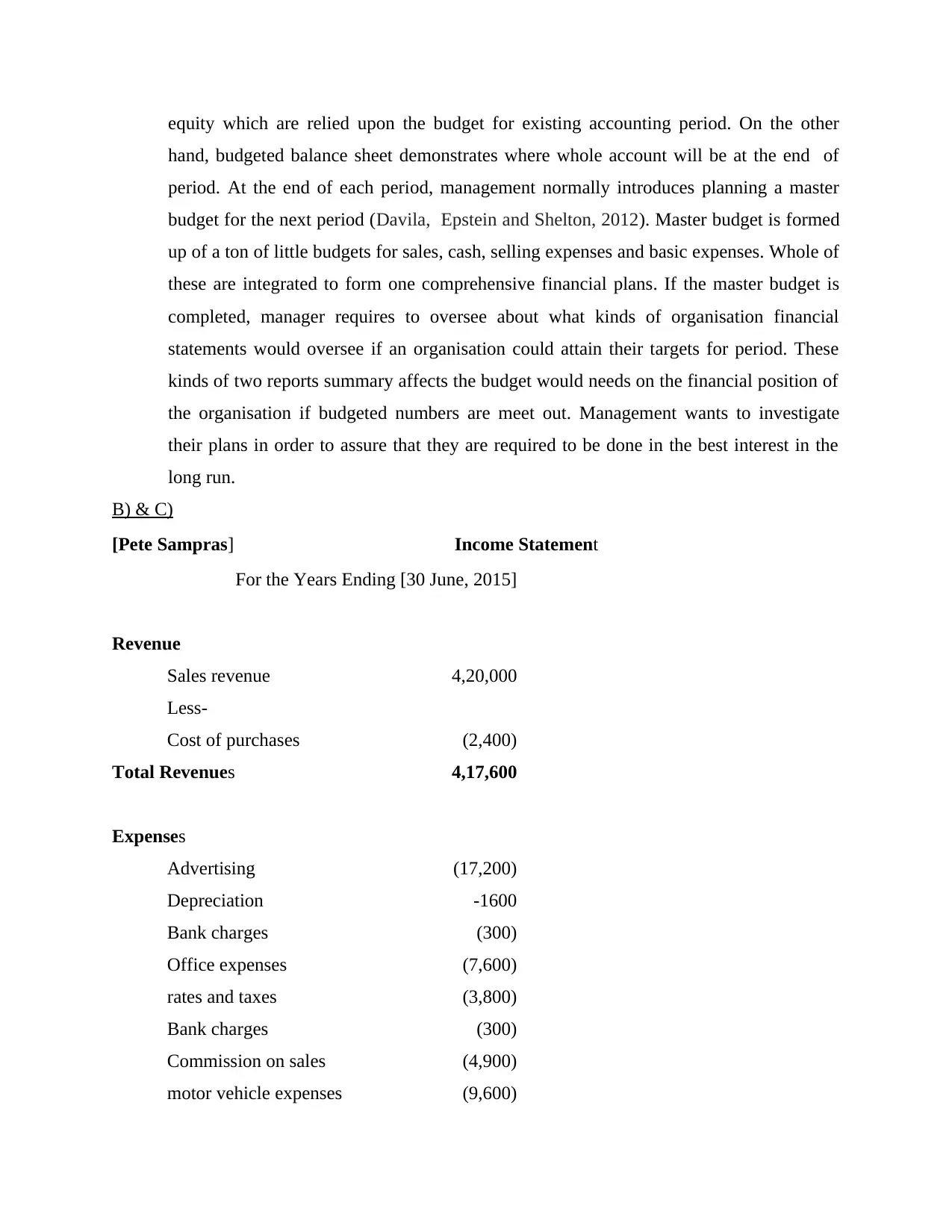
equity which are relied upon the budget for existing accounting period. On the other
hand, budgeted balance sheet demonstrates where whole account will be at the end of
period. At the end of each period, management normally introduces planning a master
budget for the next period (Davila, Epstein and Shelton, 2012). Master budget is formed
up of a ton of little budgets for sales, cash, selling expenses and basic expenses. Whole of
these are integrated to form one comprehensive financial plans. If the master budget is
completed, manager requires to oversee about what kinds of organisation financial
statements would oversee if an organisation could attain their targets for period. These
kinds of two reports summary affects the budget would needs on the financial position of
the organisation if budgeted numbers are meet out. Management wants to investigate
their plans in order to assure that they are required to be done in the best interest in the
long run.
B) & C)
[Pete Sampras] Income Statement
For the Years Ending [30 June, 2015]
Revenue
Sales revenue 4,20,000
Less-
Cost of purchases (2,400)
Total Revenues 4,17,600
Expenses
Advertising (17,200)
Depreciation -1600
Bank charges (300)
Office expenses (7,600)
rates and taxes (3,800)
Bank charges (300)
Commission on sales (4,900)
motor vehicle expenses (9,600)
hand, budgeted balance sheet demonstrates where whole account will be at the end of
period. At the end of each period, management normally introduces planning a master
budget for the next period (Davila, Epstein and Shelton, 2012). Master budget is formed
up of a ton of little budgets for sales, cash, selling expenses and basic expenses. Whole of
these are integrated to form one comprehensive financial plans. If the master budget is
completed, manager requires to oversee about what kinds of organisation financial
statements would oversee if an organisation could attain their targets for period. These
kinds of two reports summary affects the budget would needs on the financial position of
the organisation if budgeted numbers are meet out. Management wants to investigate
their plans in order to assure that they are required to be done in the best interest in the
long run.
B) & C)
[Pete Sampras] Income Statement
For the Years Ending [30 June, 2015]
Revenue
Sales revenue 4,20,000
Less-
Cost of purchases (2,400)
Total Revenues 4,17,600
Expenses
Advertising (17,200)
Depreciation -1600
Bank charges (300)
Office expenses (7,600)
rates and taxes (3,800)
Bank charges (300)
Commission on sales (4,900)
motor vehicle expenses (9,600)
⊘ This is a preview!⊘
Do you want full access?
Subscribe today to unlock all pages.

Trusted by 1+ million students worldwide
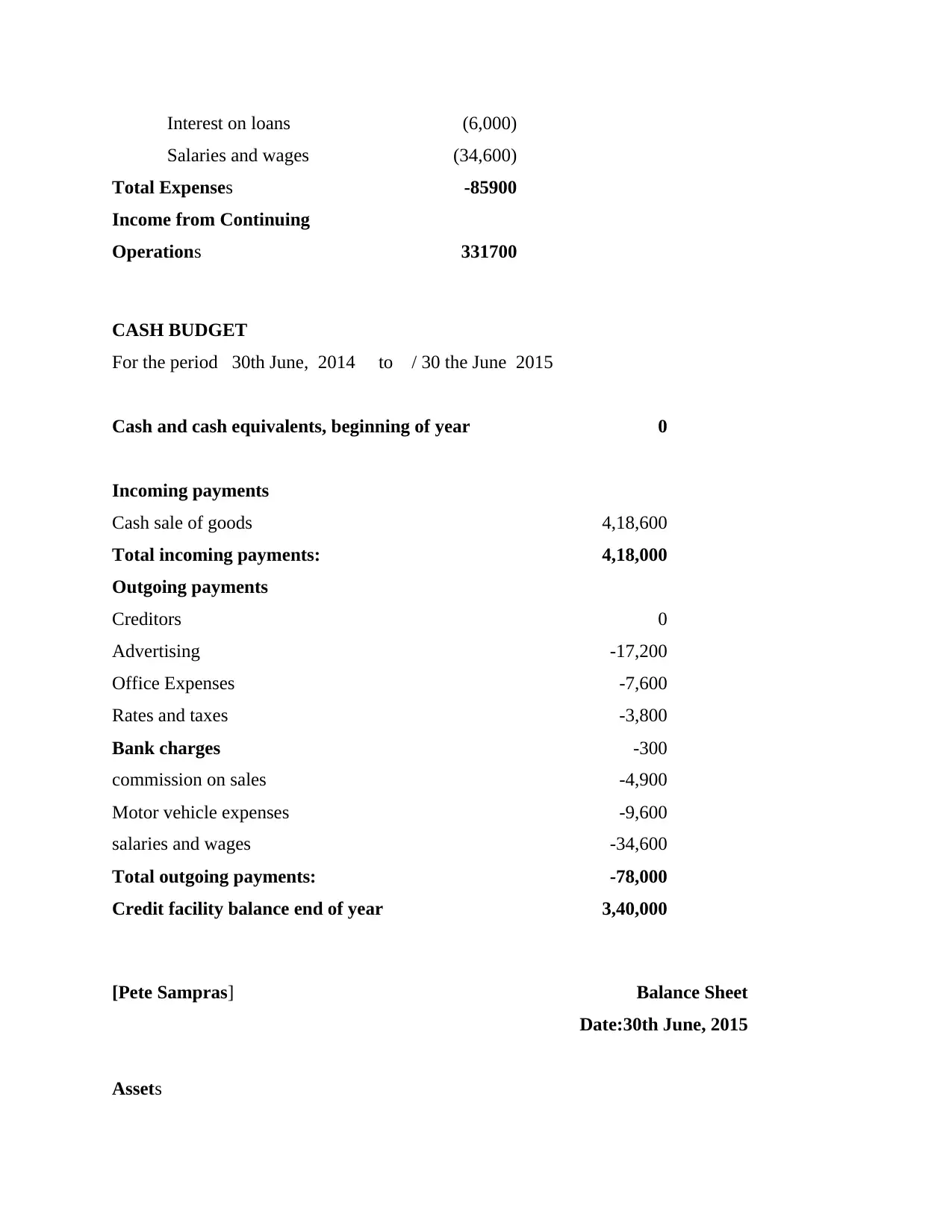
Interest on loans (6,000)
Salaries and wages (34,600)
Total Expenses -85900
Income from Continuing
Operations 331700
CASH BUDGET
For the period 30th June, 2014 to / 30 the June 2015
Cash and cash equivalents, beginning of year 0
Incoming payments
Cash sale of goods 4,18,600
Total incoming payments: 4,18,000
Outgoing payments
Creditors 0
Advertising -17,200
Office Expenses -7,600
Rates and taxes -3,800
Bank charges -300
commission on sales -4,900
Motor vehicle expenses -9,600
salaries and wages -34,600
Total outgoing payments: -78,000
Credit facility balance end of year 3,40,000
[Pete Sampras] Balance Sheet
Date:30th June, 2015
Assets
Salaries and wages (34,600)
Total Expenses -85900
Income from Continuing
Operations 331700
CASH BUDGET
For the period 30th June, 2014 to / 30 the June 2015
Cash and cash equivalents, beginning of year 0
Incoming payments
Cash sale of goods 4,18,600
Total incoming payments: 4,18,000
Outgoing payments
Creditors 0
Advertising -17,200
Office Expenses -7,600
Rates and taxes -3,800
Bank charges -300
commission on sales -4,900
Motor vehicle expenses -9,600
salaries and wages -34,600
Total outgoing payments: -78,000
Credit facility balance end of year 3,40,000
[Pete Sampras] Balance Sheet
Date:30th June, 2015
Assets
Paraphrase This Document
Need a fresh take? Get an instant paraphrase of this document with our AI Paraphraser
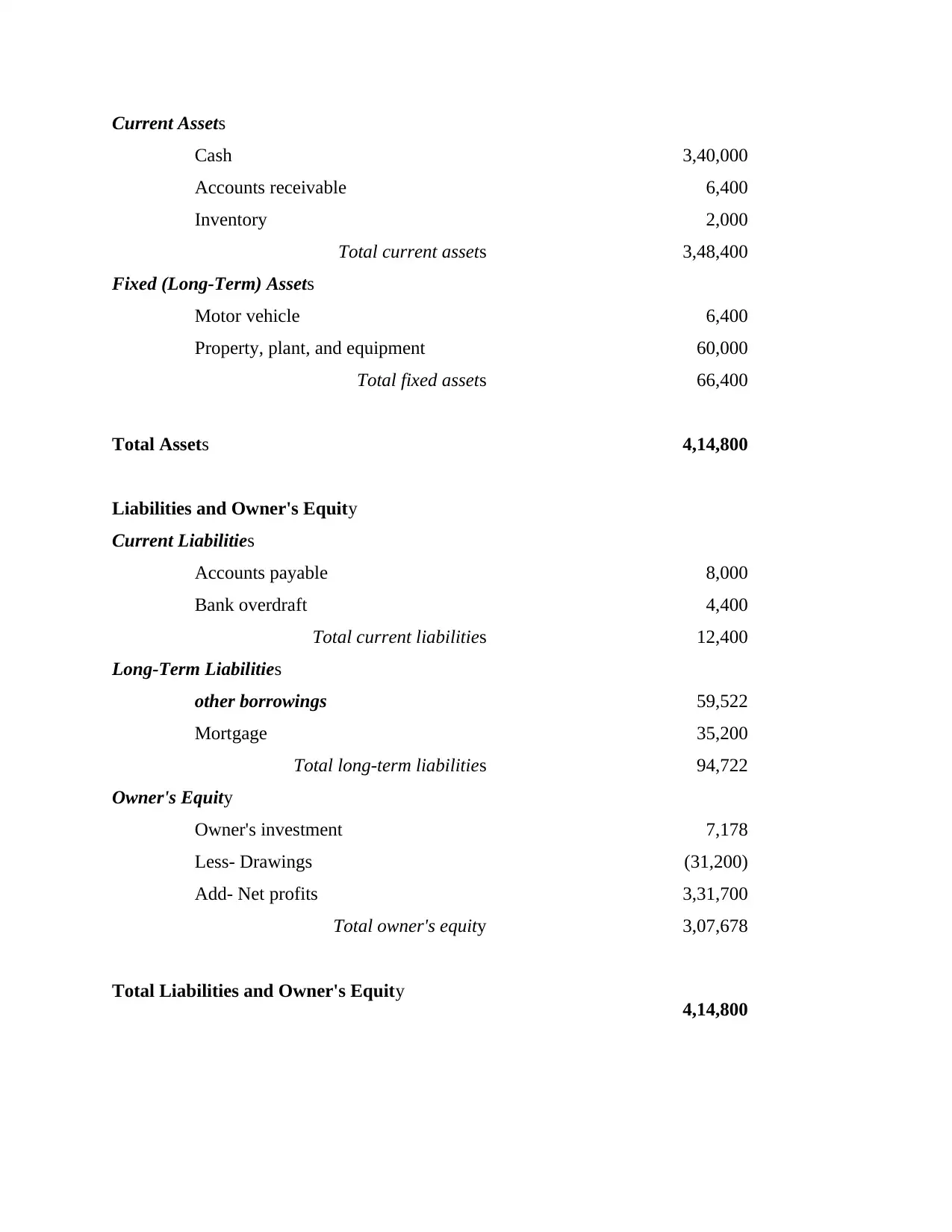
Current Assets
Cash 3,40,000
Accounts receivable 6,400
Inventory 2,000
Total current assets 3,48,400
Fixed (Long-Term) Assets
Motor vehicle 6,400
Property, plant, and equipment 60,000
Total fixed assets 66,400
Total Assets 4,14,800
Liabilities and Owner's Equity
Current Liabilities
Accounts payable 8,000
Bank overdraft 4,400
Total current liabilities 12,400
Long-Term Liabilities
other borrowings 59,522
Mortgage 35,200
Total long-term liabilities 94,722
Owner's Equity
Owner's investment 7,178
Less- Drawings (31,200)
Add- Net profits 3,31,700
Total owner's equity 3,07,678
Total Liabilities and Owner's Equity 4,14,800
Cash 3,40,000
Accounts receivable 6,400
Inventory 2,000
Total current assets 3,48,400
Fixed (Long-Term) Assets
Motor vehicle 6,400
Property, plant, and equipment 60,000
Total fixed assets 66,400
Total Assets 4,14,800
Liabilities and Owner's Equity
Current Liabilities
Accounts payable 8,000
Bank overdraft 4,400
Total current liabilities 12,400
Long-Term Liabilities
other borrowings 59,522
Mortgage 35,200
Total long-term liabilities 94,722
Owner's Equity
Owner's investment 7,178
Less- Drawings (31,200)
Add- Net profits 3,31,700
Total owner's equity 3,07,678
Total Liabilities and Owner's Equity 4,14,800
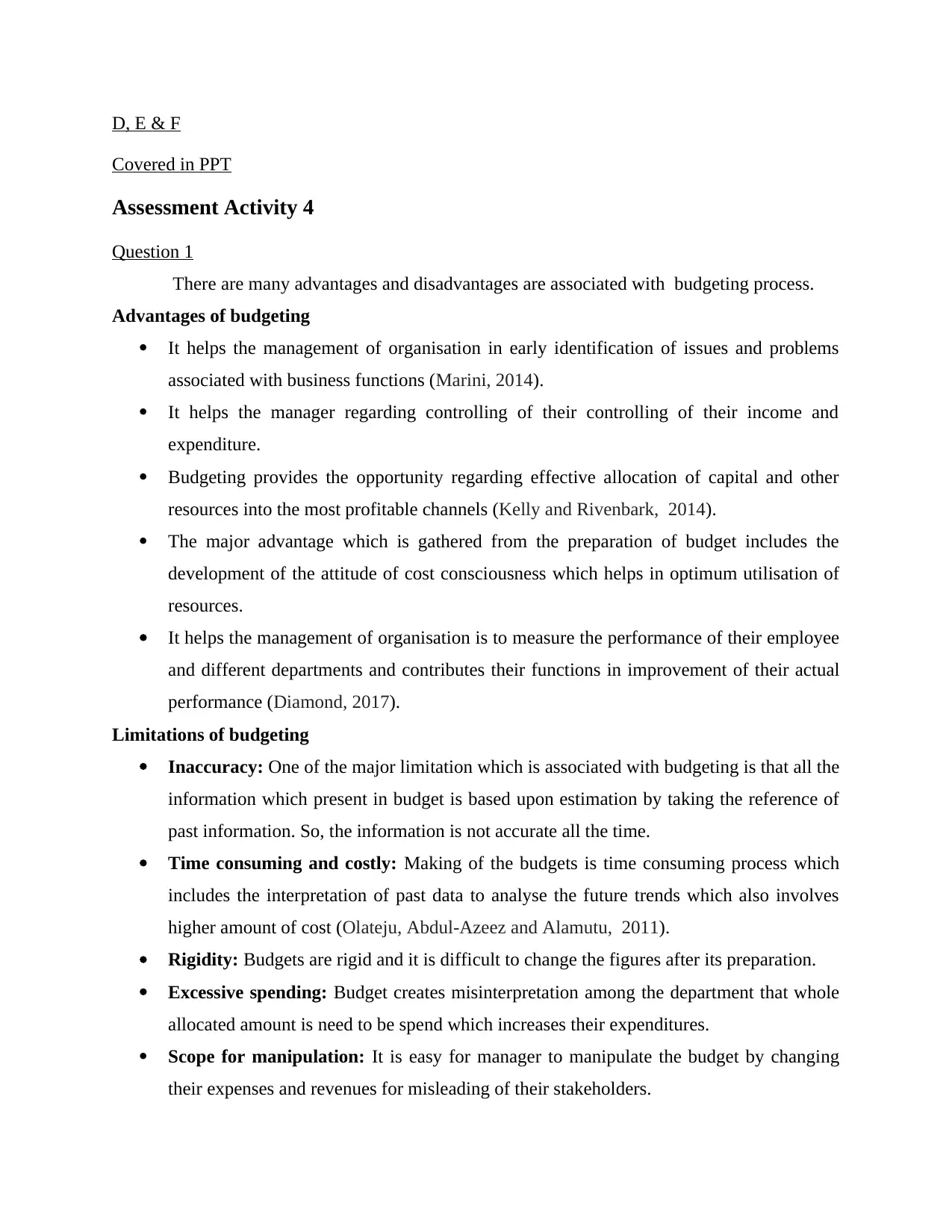
D, E & F
Covered in PPT
Assessment Activity 4
Question 1
There are many advantages and disadvantages are associated with budgeting process.
Advantages of budgeting
It helps the management of organisation in early identification of issues and problems
associated with business functions (Marini, 2014).
It helps the manager regarding controlling of their controlling of their income and
expenditure.
Budgeting provides the opportunity regarding effective allocation of capital and other
resources into the most profitable channels (Kelly and Rivenbark, 2014).
The major advantage which is gathered from the preparation of budget includes the
development of the attitude of cost consciousness which helps in optimum utilisation of
resources.
It helps the management of organisation is to measure the performance of their employee
and different departments and contributes their functions in improvement of their actual
performance (Diamond, 2017).
Limitations of budgeting
Inaccuracy: One of the major limitation which is associated with budgeting is that all the
information which present in budget is based upon estimation by taking the reference of
past information. So, the information is not accurate all the time.
Time consuming and costly: Making of the budgets is time consuming process which
includes the interpretation of past data to analyse the future trends which also involves
higher amount of cost (Olateju, Abdul-Azeez and Alamutu, 2011).
Rigidity: Budgets are rigid and it is difficult to change the figures after its preparation.
Excessive spending: Budget creates misinterpretation among the department that whole
allocated amount is need to be spend which increases their expenditures.
Scope for manipulation: It is easy for manager to manipulate the budget by changing
their expenses and revenues for misleading of their stakeholders.
Covered in PPT
Assessment Activity 4
Question 1
There are many advantages and disadvantages are associated with budgeting process.
Advantages of budgeting
It helps the management of organisation in early identification of issues and problems
associated with business functions (Marini, 2014).
It helps the manager regarding controlling of their controlling of their income and
expenditure.
Budgeting provides the opportunity regarding effective allocation of capital and other
resources into the most profitable channels (Kelly and Rivenbark, 2014).
The major advantage which is gathered from the preparation of budget includes the
development of the attitude of cost consciousness which helps in optimum utilisation of
resources.
It helps the management of organisation is to measure the performance of their employee
and different departments and contributes their functions in improvement of their actual
performance (Diamond, 2017).
Limitations of budgeting
Inaccuracy: One of the major limitation which is associated with budgeting is that all the
information which present in budget is based upon estimation by taking the reference of
past information. So, the information is not accurate all the time.
Time consuming and costly: Making of the budgets is time consuming process which
includes the interpretation of past data to analyse the future trends which also involves
higher amount of cost (Olateju, Abdul-Azeez and Alamutu, 2011).
Rigidity: Budgets are rigid and it is difficult to change the figures after its preparation.
Excessive spending: Budget creates misinterpretation among the department that whole
allocated amount is need to be spend which increases their expenditures.
Scope for manipulation: It is easy for manager to manipulate the budget by changing
their expenses and revenues for misleading of their stakeholders.
⊘ This is a preview!⊘
Do you want full access?
Subscribe today to unlock all pages.

Trusted by 1+ million students worldwide
1 out of 22
Related Documents
Your All-in-One AI-Powered Toolkit for Academic Success.
+13062052269
info@desklib.com
Available 24*7 on WhatsApp / Email
![[object Object]](/_next/static/media/star-bottom.7253800d.svg)
Unlock your academic potential
Copyright © 2020–2025 A2Z Services. All Rights Reserved. Developed and managed by ZUCOL.



